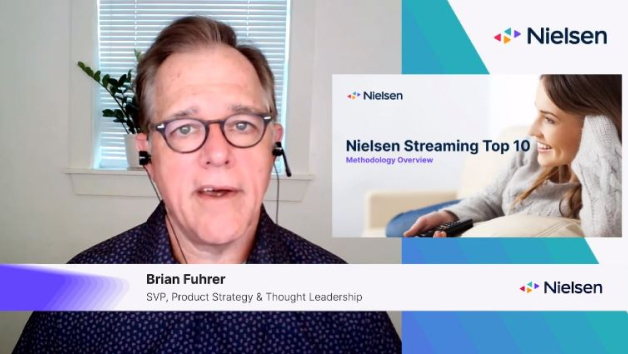TV in streaming
Top 10
Visione di film originali e acquisiti
Scoprite i migliori programmi in streaming negli Stati Uniti, compresi gli originali, i film e i titoli acquisiti più visti in streaming. Classificati per minuti totali di visione da parte di persone di età superiore ai 2 anni.
Fonte: Nielsen Streaming Content Ratings (Amazon Prime Video, AppleTV+, Disney+, Hulu, Max, Paramount+, Peacock e Netflix), Nielsen National TV Panel, Stati Uniti, visione attraverso la televisione.
Approfondimenti correlati

Panoramica sulla metodologia
Per saperne di più su come misuriamo i contenuti in streaming e calcoliamo gli elenchi della Top 10 in questo video con Brian Fuhrer, SVP di Nielsen.
Prodotto correlato

Valutazioni dei contenuti in streaming
Scopri le abitudini di visione del pubblico dello streaming per ottenere una visione più completa della portata dei tuoi contenuti video, indipendentemente da dove i consumatori li vedono.
TV tradizionale
Top 10
Visione via radio e via cavo
Scoprite cosa guardano gli americani in TV, comprese le trasmissioni più importanti della settimana, quelle via cavo e i programmi in onda. Basato sugli ascolti televisivi nazionali Nielsen e classificato in base agli spettatori totali (persone di età superiore ai 2 anni).
Fonte: Valutazioni televisive nazionali Nielsen. Pubblico statunitense. Classificato per spettatori totali P2+. I rating sono la percentuale di spettatori televisivi negli Stati Uniti che si sono sintonizzati su uno specifico programma televisivo.
Visualizzazione in base ai dati demografici
Approfondite i dati con i programmi di prima serata trasmessi via cavo e via cavo per gli spettatori ispanici, gli spettatori di colore e gli spettatori di famiglie con coniugi dello stesso sesso o partner non sposati negli Stati Uniti.
Fonte: Nielsen: Nielsen. Programmi trasmessi in prima serata. Le stime di ascolto riportate in questa pagina includono la visione in diretta e la riproduzione su DVR nello stesso giorno, definito dalle 3 del mattino alle 3 del mattino. Gli ascolti sono la percentuale di spettatori televisivi negli Stati Uniti che si sono sintonizzati su un programma televisivo.
Prodotto correlato

Valutazioni televisive Nielsen
Scoprite cosa guarda il pubblico statunitense - dove, quando e con quale frequenza - per determinare come allocare al meglio la spesa pubblicitaria, le sponsorizzazioni e il marketing.
Approfondimenti correlati

Valutazioni e famiglie
Come funzionano gli ascolti Nielsen? Si parte dalle Famiglie Nielsen che ci aiutano a misurare ciò che la gente guarda in TV e ascolta alla radio.
Pubblicità
Top 10
Scoprite quali aziende sono in testa alla classifica della spesa pubblicitaria mensile. Basato su Nielsen Ad Intel.
Fonte: Note Nielsen Ad Intel: Sono esclusi i PSA. Spot TV Live+7 per P2+. Spot TV comprende i 10 principali DMA ispanici di Nielsen in base alle famiglie televisive. I prezzi della pubblicità politica variano a seconda delle emittenti e sono soggetti a modifiche, pertanto non possono essere confrontati con periodi precedenti.
Nota: i dati relativi alla spesa pubblicitaria promozionale non autorizzata e alle impression sono esclusi dal grafico.
Prodotto correlato

Ad Intel
Distingui il tuo marchio dalla concorrenza con l'intelligenza pubblicitaria attraverso i canali e le piattaforme, tra cui TV, stampa, digitale, out-of-home e cinema.
Videogiochi
Top 10
Scoprite i principali videogiochi che gli americani vogliono acquistare prossimamente.
Settimana conclusa il 17 agosto 2024 | Console e PC
| TITOLO | RANK | Classifica | Classifiche della settimana precedente |
|---|---|---|---|
| Grand Theft Auto VI |
1
|
1 | 1 |
| Call of Duty: Black Ops 6 |
2
|
2 | 3 |
| Fortnite |
3
|
3 | 6 |
| EA Sports Madden NFL 25 |
4
|
4 | 2 |
| Anello di Elden |
5
|
5 | 20 |
| Guerre stellari: I fuorilegge |
6
|
6 | 7 |
| NBA 2K25 |
7
|
7 | 4 |
| Mito nero: Wukong |
7
|
7 | 7 |
| Silent Hill 2 (2024) |
9
|
9 9 | 11 |
| EA Sports College Football 25 |
10
|
10 10 | 20 |
| Frostpunk 2 |
10
|
10 10 | 29 |
Fonte: Monitoraggio dei videogiochi Nielsen

